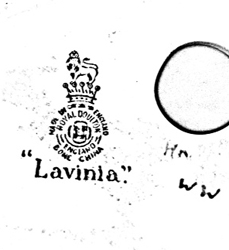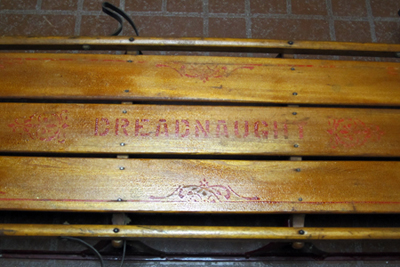 |
|
|||
 |
 |
|||
RINKER ON COLLECTIBLES — Column #1411 Copyright © Harry Rinker, LLC 2014
Questions
and Answers
ANSWER: The first rule in authenticating is to assume every object is a reproduction (exact copy), copycat (stylistic copy), fantasy item (type, form, or pattern that never existed historically), or fake (item deliberately meant to deceive). Do not assume the object is period/correct. The object has to prove that it is. Research and observation are the tools authenticators use. Royal Doulton did make a “Lavinia” figure between 1940 and 1979. “Lavinia” is a young lady who is wearing a red dress and white bonnet secured by a blue ribbon with a bow in the front. She is carrying a basket in her right hand. Leslie Harradine designed the 5 1/2 inch figure. It is marked “HN 1955 / Rd. No. 838507.” There are numerous photographs of “Lavinia” on the internet. Based on the above information, measure the height of your “Lavinia” figure. If taller or shorter (the more likely of the two) than 5 1/2 inches, there is a problem. Compare the quality of workmanship and colors to the photographs of the “Lavinia” figure available on the internet. If the quality or colors do not match, Royal Doulton did not make your figure. It is incorrect to assume that every faked mark fails to match the quality of a manufacturer’s mark. In some cases, the quality is the same or better. The idiom “the devil is in the details” applies. When a mark is copied, the copy tends to lack some of the detail found in the mark from which it was copied. The mark on your piece lacks detail. The copy is extremely poor. The mark is a copy of a Royal Doulton mark used between 1932 and 1972. The absence of a proper HN number and the odd “WW” raise serious questions. [See: http://www.antique-marks.com/doulton-marks.html]. When attempting to sell pieces such as this, unscrupulous dealers often suggest the example is a factory prototype. Any such claim should set off alarm bells. If a dealer does not use this strategy, he/she might try the “factory second” approach. Royal Doulton did not release factory seconds during the period when your figure was made. The fact that your grandmother owned the “Lavinia” figure means little. You have no evidence that she acquired it as a young woman. She could have acquired it within a few years of her death. Her acquisition story is lost to time. Royal Doulton figures are hollow. As a result, a hole or holes are necessary to allow the water vapor to escape during the firing processes. Normally, these holes are small or hidden. The hole on the bottom of your figure is exceptionally large, not a Royal Doulton production methodology. The obvious conclusion is that you have a Royal Doulton copycat or fake. Since your email contains only a picture of the base of the figure, I am not able to offer an opinion as to which of the two applies. QUESTION: I own a pin and earring set that I purchased in the late 1950s or early 1960s. The pin is shaped like a hexagon. Each side measures approximately one inch. The pin is filled with small, sparkling glass pieces in a variety of colors – blue, rose, and yellow. I can see “B. David,” perhaps the name of the manufacturer or designer, on the back of the pin. I would appreciate any information you can provide about the pin and earring set and its value. – DM, Minneapolis, KS ANSWER: Preston Reuther’s Vintage Jewelry website contains this information about B. David: “B. David jewelry was made from 1943 to 1993 in Cincinnati, Ohio….B. David jewelry was set apart from the crowd by its style….costume jewelry pieces tended to be small (in scale) and elegant as opposed to some of the larger and flashier costume jewelry….B. David jewelry can be described as delicate, often demonstrating eye-catching combinations of different sized rhinestones, such as round and teardrop shapes in the same piece. Typical…pieces also exhibit attractive pastel colors…. “B. David costume jewelry pieces may be signed ‘B. David’ in an oval, ‘bd’ printed diagonally, or “b.David” in a divided square. Earrings may have an etched swirling design in place of a signature or mark on the clip back….Of particular interest to collectors are B. David costume jewelry sets: of a necklace and earrings or a pin and earrings.” [See: http://www.antiquecameos.com/pages/vintage_jewelry_david.html] A quick check of eBay produced over 200 listings, most of the “Buy It Now” variety. Although I was not able to find an example of the pin and earring set that you own, I found enough comparables to provide a value. Value for your set is between $18.00 and $22.00. QUESTION: After my grandfather passed away, I acquired his Garton “DREADNAUGHT” sled. It is 90 inches in length, has a front steering mechanism, and has a handle near the middle on each side. I am having trouble finding information about the sled. Can you help? – MW, Herrington Park, NJ, Email Questions
ANSWER: In “Rinker on Collectible” #1329 in response to a question about a Garton pedal car, I provided the following information about the Garton Toy Company: “The old Garton Toy Factory Riverside plant, located at 830 North Water Street, Sheboygan, is now luxury apartments. Its website, http://www.gormancompany.com/webv1/rent_search/garton_toy.htm, contains this history: “The Garton Toy Company, founded in Sheboygan in 1879 [by Eusebius Bassingdale Garton], is remembered for the production of the pedal car along with sleds, tricycles, coaster wagons, croquet sets and toy cradles. Of all the toy pedal cars produced, they are best known for the creation of the ‘Kidillac’ and the ‘Hot Rod.’ The company’s production reached a broad market throughout the country through national catalog sales and distribution centers….During the 1960s, Garton Toy Company introduced several new toy products including the Casey Jones Locomotive, Air Force Jeeps, Tin-Lizzies, Spin-A-Roos, a surrey, a camper and sedans to the toy market. To become more efficient and to modernize, they decided to build a new plant and relocate four miles north of Sheboygan.” While I found information about a number of Garton sleds, I was not able to determine a manufacturing date for the DREADNAUGHT.” My initial thought was that the sled dates from the late 1940s or early 1950s. However, I did the bulk of my sledding on Hellertown[PA]’s Front Street and Depot Street hills and never remember seeing a sled of that size, seven and one-half feet, on the hills or in stores. Sled steering mechanisms date to the late 19th century, a fact that provides little help in dating your sled. I did find an eBay listing for a 1943 Garton sled advertisement tear sheet from a Drake Hardware Company catalog. The advertisement featured “Fleetwing” sleds, the largest measuring 47 inches. My best guesstimate is that the sled dates from the 1930s. The size is the key value determinant. Based on my evaluation of the pictures that accompanied your email, the sled’s secondary market value is around $100.00.
QUESTION: I own an 11 inch vase that is marked on the bottom “Avalon Faience.” The body of the vase is tan. There is a relief grape motif on a checkerboard background. Does this have any value? – B, State College, PA ANSWER: According to Edwin Atlee Barber’s Marks of American Potters, Henry Brougham, Isaac Brougham, and John Tunstall, founded Chesapeake Pottery of Baltimore, Maryland, in 1880 or 1881. Yellow baking ware and Rockingham glazed utensils were its early products. D. F. Haynes Company purchased Chesapeake Pottery in 1882. The ownership changed several times during the next two decades, eventually becoming D. F. Haynes & Son. A triangular “Avalon” faience mark was in place by the mid-1880s. Lois Lehner’s Lehner’s Encyclopedia of U. S. Marks on Pottery, Porcelain & Clay (Collector Books, 1988) provides this additional information: “When David [Haynes] died in 1908, his son Frank assumed complete control. In 1914, the American Sugar Refining Company purchased the property [corner of Nicolson and Decatur streets] and the pottery business was discontinued at the Chesapeake Pottery site.” Lehner notes the majolica period dates from 1881 to 1890. The “Avalon” ware had a “fine body, ivory tint, and soft rich glaze ornamented with sprays of flowers in relief. Given its age and American origin, the secondary market for Avalon Faience is weak, as evidenced by eBay asking prices ranging from $40.00 to $200.00. Most of the pieces listed on eBay do not sell through, even those with low opening bid requests or Buy-It-Now prices. This suggests that supply exceeds demand. It is hard to place a value on your vase without seeing a picture. My recommendation is to think conservatively – under $50.00.Harry L. Rinker welcomes questions from readers about
collectibles, those mass-produced items from the twentieth and twenty-first centuries.
Selected letters will be answered in this column.
Harry cannot provide personal answers.
Photos and other material submitted cannot be
returned.
Send your questions to: Rinker on Collectibles, 5955 Mill
Point Court SE, Kentwood, MI 49512.
You also can e-mail your questions to
harrylrinker@aol.com.
Only e-mails containing a full name and mailing address
will be considered.
You can listen
and participate in
WHATCHA GOT?, Harry’s
antiques and collectibles radio call-in show, on Sunday mornings between 8:00 AM
and 10:00 AM Eastern Time.
If you
cannot find it on a station in your area,
WHATCHA GOT?
streams live on the Internet at www.gcnlive.com.
SELL, KEEP OR TOSS?: HOW TO DOWNSIZE A HOME,
SETTLE AN ESTATE, AND APPRAISE PERSONAL PROPERTY
(House of Collectibles, an imprint of Random House Information Group, $17.99),
Harry’s latest book, is available at your favorite bookstore and via
www.harryrinker.com.
|
||||
 QUESTION: I have a Royal Doulton “Lavinia” figure that I received from my grandmother. The logo on the bottom does not match the logo I found on websites featuring Royal Doulton marks. There is an “HN” but no number after it. What exactly do I have? – BN, Email Question
QUESTION: I have a Royal Doulton “Lavinia” figure that I received from my grandmother. The logo on the bottom does not match the logo I found on websites featuring Royal Doulton marks. There is an “HN” but no number after it. What exactly do I have? – BN, Email Question
